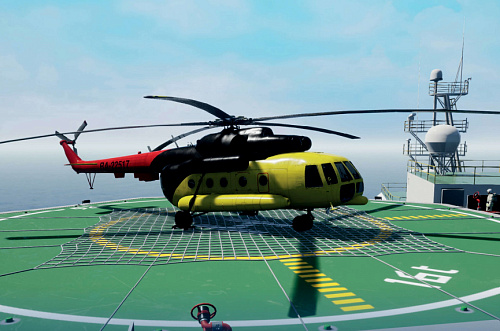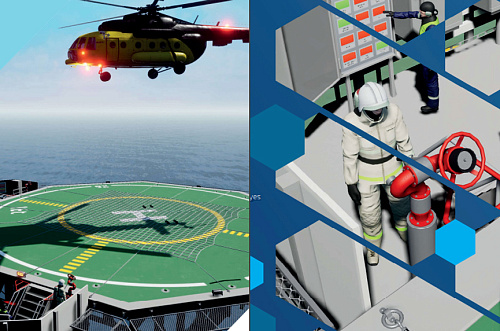Purpose
Multi-user Helideck VR simulator is designed for marine personnel qualification assessment and training to conduct offshore helicopter operations on any offshore platform or vessel.
Training goals
Practical exercises for HLO/HDA personnel include elaboration ofthe following skills:
- Familiarization with procedures, regulations and regulatory documents
- Job description and responsibilities of the personnel involved
- Key aspects of briefings for the helicopter operations (ops) support group
- Radio communication skills development for safer carrying out of operations
- Coordination of vessel and helicopter crews' actions
- Preparation of the helideck for landing
- Skills to operate specific helideck equipment
- Safe landing and takeoff
- Loading and unloading of passengers and cargo
- Prompt response to emergency situations
Chemical Tanker
Workplaces for instructor and student(s) are available.
Exercise participants perform tasks according to their assigned roles and work out the coordination of the helicopter operations (ops) support group:
- PIC - pilot on command
- OOW - Officer of the charge
- HDA - Helideck assisstant
- SS - Support (working staff)
- HLO - Helicopter landing officer
- M - Master
Stages of the ongoing exercise follow the formal procedure ofthe scenario being performed. Interaction among participants is organized by the voice messages transmission between workstations, which simulates radio communication.
Instructor
Instructor supervises training and learning processes using a desktop PC and workstation software with allthe necessary functionality, which provides full control ofthe exercise:
- Exercise initialization and client operation control
- Training module (a resource to conduct the exercise) to be selected
- Exercise mode to be selected: a training mode or an exam mode
- Tips in training mode, which facilitate the exercise completion
- Correctness evaluation for all steps and stages of the exercise
- Role assignment and establishing a connection to the exercise
- Managing the ongoing exercise and creating various emergency situations
- Unhindered movement within a virtual scene
- Voice commands to other participants via the radio communication
- Exercise recording and playback
Student
PC client
Use keyboard, mouse, game controllerand thevisualization available onthe PC monitor to interact with the virtual environment.
VR client
Use ofVR controllers and visualization is availablein the VR headset to interact with the virtual environment.
Moving within the training area space allowsmoving in a virtual scene. The accessible areaandsafety rules are determined by the instructor atthe exercise preparation stage.
Regardless of the configuration,the following functionality is available:
- Viewing the final results of an exercise
- Confirmation of readiness to start the exercise
- Software setup and radio communication try-out
- Moving in the virtual scene
- Interaction with helideck equipment
- Radio communication between the participants ofthe exercise
- Setting up the voice commands, which aretobe given to other participants ofthe exercise
Tips are introduced for the training mode: necessary actions to be taken and goals to be reached are displayed over objects in the virtual environment at each step ofthe exercise.
Potential emergency situations
Students also acquire skills to quickly respond to the following potential emergency situations:
- Exiting the helicopter towards tail rotor
- Forgotten brake pads
- Crane operations before helicopter landing or taking off
- Outman access to the helideck
- Loss of communication between
- HLO and navigation bridge
- Exiting the helicopter in a helmet
- Loss of communication between
- HLO and helicopter crew
- Incorrect net mount (e.g. loose sling)
- Loss of orientation in case of distress or getting a foreign object (dust) into man's eyes
Regulations
- Article 7 requirements of IMO Resolution A.741 (18) "International Safety Management (ISM) Code",
- IMO Resolution A.1079 (28) "Recommendations for the training and certification of personnel of mobile offshore units (MOUs)",
- IMO Resolutions A.855(20) "Standards for on-board helicopter facilities", as well as considering the OPITO standards for training and assessing the competencies of helipad personnel "Helideck Operations Initial Training Standard (HLO and HDA Initial Training)", "Helideck Assistant (HDA) Workplace Competence Assessment Standard", etc.





